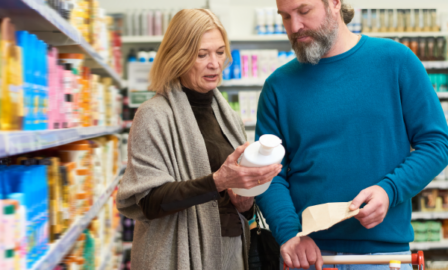How an Emphasis on Self-Care is Transforming the Beauty Industry
As society transitions to a more introspective and health-focused world, we’re seeing growth in skincare trends, wellness-oriented products, and new market segments within the beauty industry. This new integrated approach to wellness is impacting the beauty community as consumers focus on products that incorporate both natural ingredients and non-traditional products into their self-care routine – focusing not only on their internal well-being, but external, too.
As our economy is experiencing a period of inflation where consumers are looking to cut expenses, splurges on beauty and wellness will persist, particularly as self-care continues to be a priority in consumers’ budgets. In this piece, we outline how an emphasis on self-care is transforming the beauty industry today and in the years to come.
Zoom Effect
Although the idea of self-care has been around for decades and centuries, the pandemic jumpstarted a new emphasis on products focusing on self-care. As employees transitioned to remote work and Zoom meetings, more people became hyperaware of their faces and flaws, which is also known as the Zoom Effect. This combined with an overall more health-conscious population due to the fear of a pandemic stimulated a growing industry for skincare and wellness products. Although COVID health concerns and full-time remote spaces have dwindled in 2023, this trend is here to stay, as many companies have made the switch to remote and hybrid workplaces, and businesses continue to evolve to a new working culture that prioritizes mental health and wellbeing post-COVID. Regardless, self-care is trending amongst many consumer segments and will remain a staple in consumers’ day-to-day activities and overall lifestyle both in and outside of the workplace.
Lipstick Effect
Following COVID, our economy has experienced both rising inflation and consumer behavior trending toward purchasing “necessity only” spending. The Lipstick Effect is a term coined by Estée Lauder, and it’s claimed to be an economic indicator. With prices increasing with inflation and a threatening recession, you would expect beauty products to be a low priority for consumers. However, beauty sales are still rising. This phenomenon demonstrates that people are still purchasing little luxuries like lipstick during an economic strain. Even when faced with a tight budget, consumers are still turning to beauty products to feel and look good.
The overarching trend demonstrates that consumers seek comfort products during periods of stress and uncertainty. Initially, the trend started at the beginning of COVID but will continue as consumers indulge in beauty products during this continued inflationary period. For example, last year, beauty was the only discretionary retail sector that showed a year-on-year increase with makeup, haircare, and fragrance sales rising. Self-care and beauty are being prioritized by consumers, which is producing an opportunity for growth for companies in this arena.
Consumer Behavior and New Product Segments
The transition to a more self-care-oriented consumer base has generated a wave of new product segments and introduced a more holistic approach to the beauty industry. We see consumers increasingly purchasing value products surrounding body positivity and “whole body” health, such as growth in untraditional products for stretch marks and body acne treatments. This new-found purchasing behavior and popularity surrounding niche beauty items is specifically seen by younger generations. In fact, Millennials spend more on self-care than any other generation before them, spending an estimated 2x more than Baby Boomers. While older generations might view beauty products as the traditional powdering of the nose and swipe of lipstick, skincare products are now outselling makeup. The prioritization of skin care and well-being will dominate within the younger market segments as society continues to focus on self-care.
Considerations for Beauty Companies Moving Forward
The beauty and skincare industry has continued to be shaped by a myriad of reasons and is continuing to grow. For companies in this sector looking to gain a competitive advantage, consider the following factors below to boost your brand sales and image:
Understanding Your Customers
Gaining and retaining loyal customers is a challenge. Businesses need to differentiate themselves from their competitors, offer greater value, and provide a personalized customer experience. This means knowing generational consumer purchasing habits, such as what self-care means to Gen Z vs. Millennials vs. Gen X. One way to cultivate these customers is through loyalty programs and collecting first-party data. Industries surrounding self-care and beauty are ripe for innovation and opportunity, so retaining loyal customers who will make stable and consistent purchases – and provide insight into their purchasing habits and preferences – over various economic landscapes is key.
Understanding Market Trends
Understanding market trends is critical to business success. Contrary to basic assumptions, during times of inflation, the beauty industry can thrive and find products that surge in demand, as seen by the Lipstick Effect. Data that has been collected over time can assist with demand forecasting and ensure systems are using the correct information to meet customer demand.
Knowing the market enables companies to better manage expectations and inventory in uncertain times, which is essential to their profitability. Supply chain and demand forecasting must take all circumstances into consideration and anticipate the correct amount of product to have in inventory. By spending time ensuring forecasting is well executed, companies will be able to deliver the right product at the right time to the right customer.
Power of Technology
Technology innovation has been a popular conversation in the beauty industry for some time. The concept has gained momentum from evolving smartphone, digital, and consumer technology. Companies continue to experiment with various tech strategies by creating toolsets for their consumers to enhance shopping experiences. For example, selecting makeup colors that best fit your complexion, or taking skincare quizzes that help customers find the best product for their skin type. These innovative tech abilities produce personalized and impactful consumer experiences while setting companies apart from their competition. This movement towards tech could also look like utilizing social media with beauty and wellness influencers. A strong digital strategy is key for businesses so that they can capitalize on trends and evolve their strategies to create an impactful shopping experience for customers.
Looking Forward
As the self-care movement continues to grow, it’s critical for companies to build a foundation that enables them to quickly adapt and evolve with the consumers’ needs and wants. The increasing demand for health conscious and well-being products is opening up opportunities. While we may have imagined a deteriorating focus on self-care and non-necessities during a period of economic uncertainty, quite the opposite is true.
Clarkston has experience crafting strong digital strategies to meet goals and ensure lasting impacts in the beauty industry along with other sectors. While these plans take time to develop, they are critical in setting your brand apart from the rest. Strategies such as gathering analytical data and developing innovative technology can provide information to better understand customer needs, predict future trends, and guide future decisions.
To implement a strategy that caters to this new culture, our team at Clarkston can help.
Subscribe to Clarkston's Insights
Contributions from Addie Schmidt and Leah Harding



